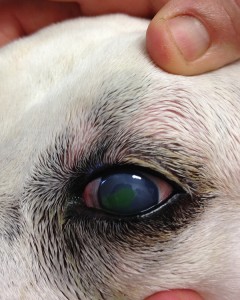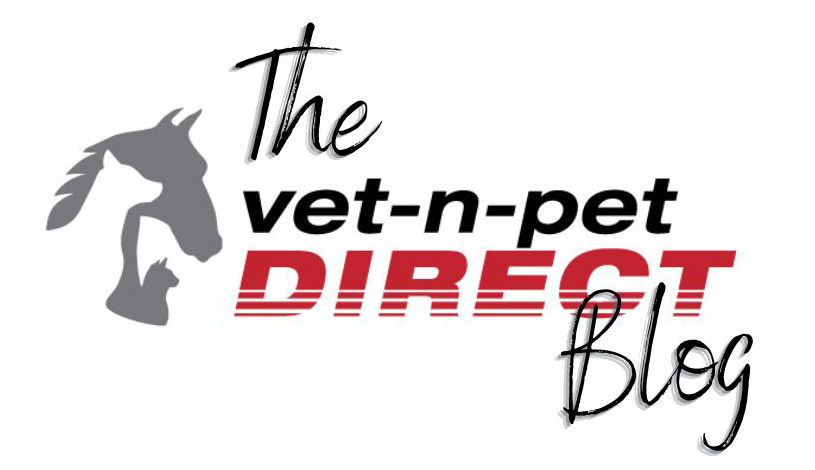
The green stain shows the corneal ulcer.
My dog Lilly has suffered from many ailments over her 12 years but one that has always been a concern is her eyes. Lilly has suffered from Dry Eye (Keratoconjunctivitis sicca) since she was three years old, which we have managed with Optimmune eye ointment. This means that Lilly does not produce enough tears to lubricate her eyes properly. Unfortunately there is no cure for Dry Eye, the disease has to be managed with the application of artificial tears, sometimes daily, to maintain eye lubrication and a healthy eye. There is also the possibility of secondary complications due to Dry Eye, even when it is being treated, like corneal ulcers, conjunctivitis, inflammation, pain and even blindness. Unfortunately this is what happened with Lilly.
About 6 months ago Lilly developed a corneal ulcer in her left eye, most likely due to the dry eye, as occasionally overtime the Optimmune can begin to have a reduced effect. I took Lilly to her vet for an examination, where he stained the eye to determine the size or the ulcer, (see image). He prescribed an antibacterial drop as well as continued use of the Optimmune drops, at an increased frequency and pain relief medication to reduce the inflammation and pain in the eye. We re-visited the vet 10 days later for a check up only to find there had been no improvement, so we continued on the same line of treatment for another four days. After those four days were up I took Lilly back to the vet as the eye was definitely still painful. There was still no improvement, so the vet decided to add visco tears (artificial tears) to help lubricate the eye even more. He also started her on Atropine eye ointment to dilate the pupil and protect against secondary glaucoma. We followed this course of treatment for another week but unfortunately it was just not improving so we had to try a more drastic approach.
As Lilly’s eye was chronically ulcerated and not responding to normal therapy the vet decided to perform a grid Keratectomy which is where they cut the epithelium membrane to stimulate corneal cells to grow and then heal the ulcer. He then stitched most of the eye closed in a procedure known as a temporary Tarsorrhaphy where the eyelids are closed with sutures. This then protects the cornea as much as possible by reducing friction caused when blinking and preventing the eye from becoming overly dry. This was all done under a general anaesthetic and Lilly was sent home with an Elizabethan Collar to stop her from rubbing her eye, antibiotics and pain relief. Lilly had her eye stitched closed for three weeks and then the vet removed the stitches to see how it had healed. Unfortunately there had not been very much improvement. There did seem to be some new corneal cell growth but not a lot and there was still an ulcer. So the vet changed her eye ointment from Optimmune to Tacrolimus Solution, a specially developed eye drop that we had made up by a Sydney pharmacist. The hope was that this new solution would cause less irritation to the eye but still provide the lubrication that was required. We tried this for a week but the Tacrolimus drops seemed to be very painful on application as Lilly would cry and rub her eye, so we had to stop them and go back to the Optimmune.
The biggest problem we were having during the treatment of Lilly’s eye was that the use of the Optimmune seemed to aggravate the corneal ulcer, but without the Optimmune the dry eye was causing more aggravation as their was not enough lubrication when she was blinking. So it seemed that no matter what we did the corneal ulcer was not healing and instead constantly being aggravated by the different treatments that should have been helping. It was quite an unusual and complicated situation.
Another week passed with still no improvement and Lilly was really starting to get sick of having drops in her eyes, which was understandable considering it had been going on now for over two months. Lilly’s vet came up with another fantastic idea to try and get the corneal cells to start redeveloping. He took some blood from Lilly, spun it down so that he could extract the serum from it to make Autologous serum drops, by adding the blood serum to some antibiotic drops (Soframycin). The serum from the dogs own blood contains numerous growth factors to help the epithelial cells of the cornea colonise the ulcer. The blood serum also contains Vitamin A which helps to keep the cornea healthy. We continued treating Lilly with the special serum drops and Optimmune for a month as well as pain relief as required.
After a month the vet re-checked Lilly’s eye only to determine that there was very minimal improvement, if any at all, and was concerned as it was still painful. After over three months of treatment we were running out of ideas and treatment options. The vet had suggested sending Lilly to an eye specialist (which he had also suggested a few months earlier). He thought perhaps an operation known as a Parotid Duct Transposition, which involves the redirection of the duct from the parotid salivary gland to the eye, might help as the saliva would then replace the tears and mean that we would not have to use the Optimmune to lubricate the eye. We decided against doing the surgery and sending her to a specialist mainly because Lilly is getting old and she suffers from a lot of anxiety, particularly when separated from me and I did not want to put her through another painful and lengthy procedure that may or may not help improve her eye.
I couldn’t stand to see Lilly in pain anymore and it was fairly unlikely that the ulcer was going to heal. She had also lost a lot of vision in that eye as a result of the damage done by the ulcer. After discussing with the vet I opted to have the eye removed. It was a big decision but ultimately it meant that she would have no more pain, no more drops and of course no more eye. The Enucleation (eye removal) procedure didn’t take very long, the vet removed the entire eyeball and then the eyelids are stitched together. As soon as Lilly got home and fully woke up from her anaesthetic she seemed to cope exceptionally well with only one eye. It was quite remarkable that she didn’t seem affected by the lose of the eye. I had expected her to crash into things or possibly be off-balance but in fact there really was no difference in her day-to-day life. Obviously she can not see things on her left side and her depth perception has been affected but overall the lose of the eye has not compromised her lifestyle in any way. Lilly was instantly (within 48 hours) happier and more relaxed, I guess it must have been a relief after having pain in her eye for months. Two weeks after surgery Lilly had the sutures removed and the wound had healed perfectly.
Today, two months on from the surgery, Lilly has made a full recovery. She copes exceptionally well with only one eye and is very happy and full of life.
Until next time,
Bec

I had the same thing 10years ago and going from we may have to remove the eye to the appointment at the willows eye
Hospital where the vet took a good look
at the eye gave him some eye MED’s and
He is still here to day and only on optimum his eyes are great …our vets do not have the right tools for the job..and he loves going for his check up’s
Hi Linda,
That is great news that the optimmune is working and your boy is still going strong. I love hearing good outcomes.
🙂
Bec